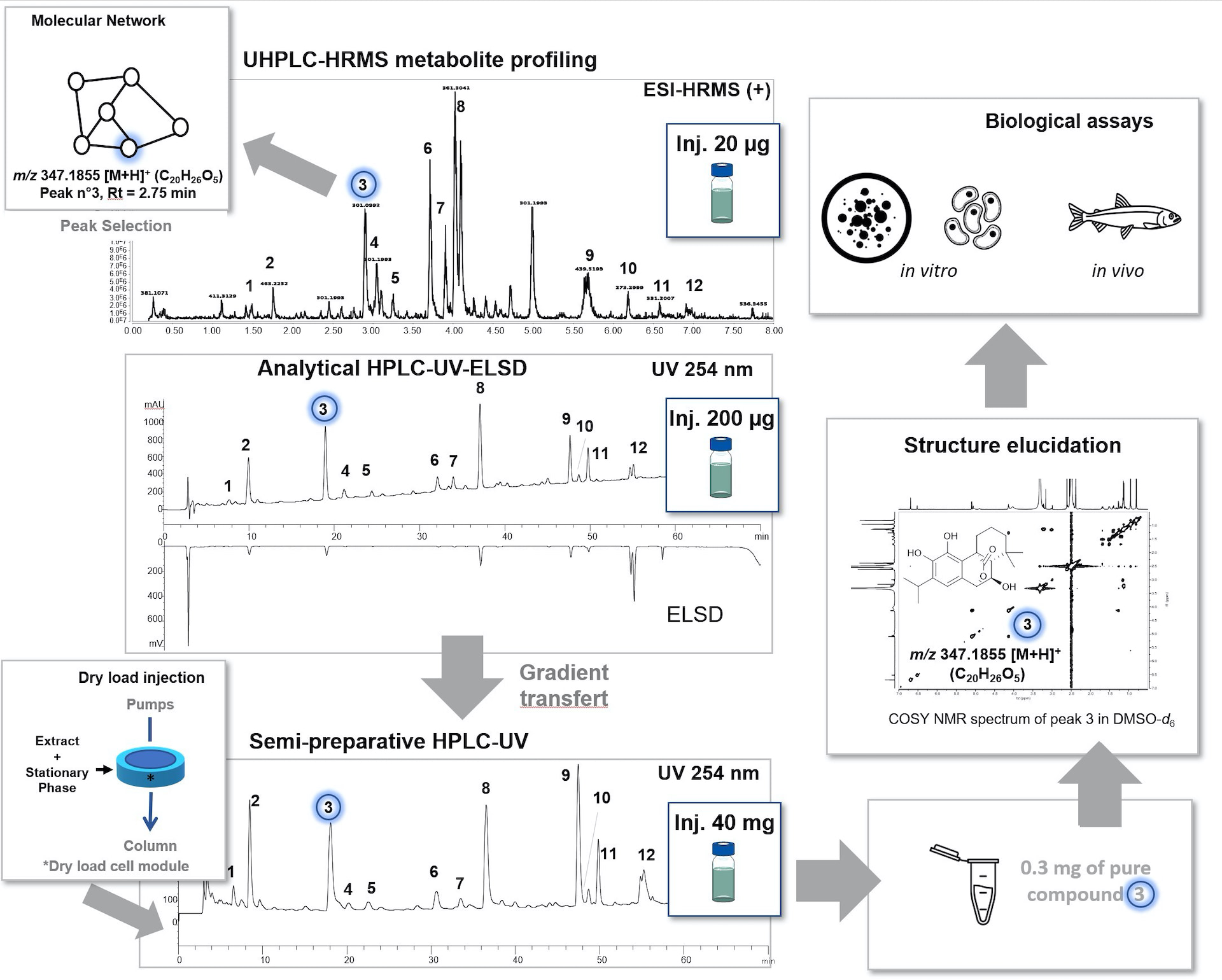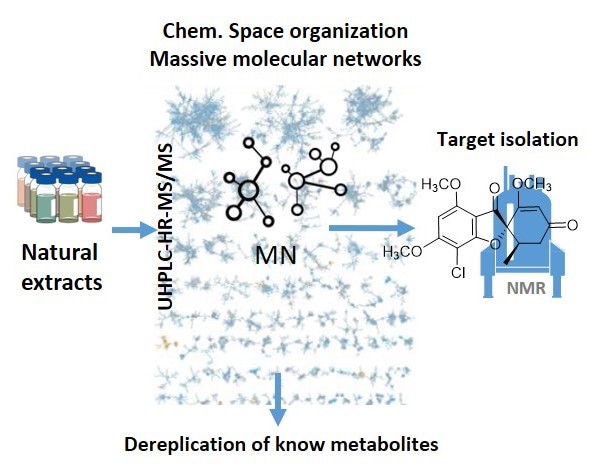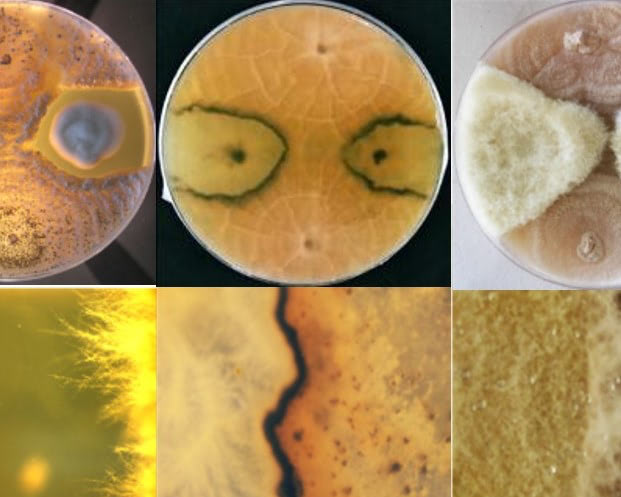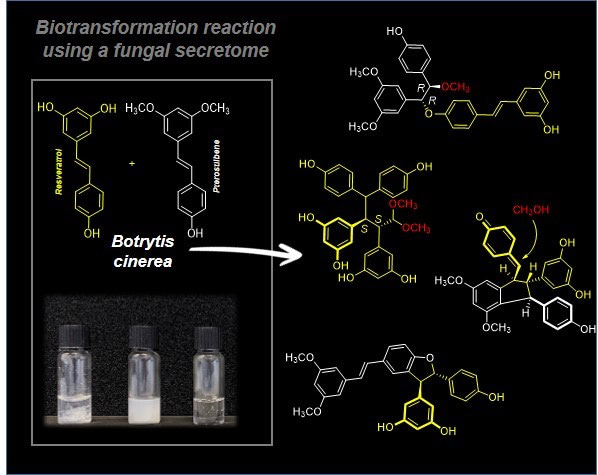
LAB OVERVIEW

The Phytochemistry and Bioactive Natural Products Unit has strong expertise the annotation of massive metabolomics datasets and in the in the de novo structure identification of bioactive natural products or biomarkers using Nuclear Magnetic Resonance (NMR) and Mass Spectrometry (MS) at the microgram scale. We develop methodological approach that combines HPLC-based metabolite profiling and bioactivity assessment of natural extracts for the targeted isolation and prioritization of given compounds. We modulate the biological/pharmacological activities of the isolated natural products (NPs) using chemical diversification methods such as biotransformation with the enzymatic machinery of fungal secretomes. We focus our research activities on developing new strategies in metabolomics for the annotation and rapid identification of NPs in complex matrices, both in plant and microorganism of diverse origin. We also develop original tools that provides a well-structured ontology in associated natural extract metadata (e.g. taxonomy) to improve confidence in annotation. We use these metabolite profiling data to target isolation of NPs at the micro- or milligram scale for comprehensive NMR and bioactivity characterization.
DISCOVERY OF SMALL-MOLECULE DRUG CANDIDATES

Our laboratory conducts various projects related to the research of bioactive NPs for the discovery of new pharmacophores and possibly therapeutic agents. To this end, we integrate MS and NMR-based metabolomic strategies to shortcut conventional activity-based isolation methods and prioritize novel NPs of interest. In this context, we develop biochemometric methods that allow the integration of biological activity results into molecular networks (MN) based on massive LC-HRMS/MS metabolite profiling of natural extracts. For efficient targeted isolation we develop new high-resolution strategy at the preparative scale that allows direct transfer of analytical metabolite profiling conditions for subsequent complete structure determination of the compound of interest at microgram scale by sensitive NMR.
STUDY OF MICROBIAL CONFRONTATIONS

We have initiated projects on the induction of defense and signaling metabolites in microbial interactions. The aim is, on one hand, to try to understand the events that trigger the response at the biochemical level by confronting organisms and, on the other hand, to exploit identify bioactive metabolites dynamically produced as a result of the interaction. Such type of studies are performed on given microorganism of therapeutic or ecological interest or at the level of complex endophytic communities of host plants. The application of metabolomic strategies to these organisms combined with co-culture experiments provide massive information on the mixed metabolomes found in such microbiota. They are deciphered by combining also metagenomics results and should finally lead to a better understanding of communication within the microorganism communities, and potentially highlight NPs with powerful antifungal and antibacterial activities.
PLANT DEFENSE - WOUND RESPONSE

In more fundamental chemical ecology studies, we also apply our metabolomic methods to identify defence compounds induced by biotic and abiotic stresses. Our research focuses notably on the wound response of Arabidopsis thaliana, which mimics the attack of herbivores, for the study of defence signalling. We have notably discovered new jasmonates and established holistic links between the induction of different phytohormones. This now leads to further targeted research to understand most of the molecular events involved in long-distance defence signalling and in particular the induction kinetics of jasmonates in distal leaves. Currently, the mobilization of the precursor of jasmonic acid, 12-oxo-phytodienoic acid (OPDA), in both free and bound forms is being investigated in depth. The ultimate goal is to decipher how defence signalling propagates through the systemic part of plants and ultimately leads to defence against herbivores.
CHEMICAL DIVERSIFICATION/BIOTRANSFORMATION

Natural products have been the starting point for the development of large number of therapeutic drugs along the history. The classical way to obtain bioactive natural products is the bioassay-guided fractionation of an active extract obtained from a plant or microorganism. Bioactive NPs have also been obtained using biological methods such as biotransformation reactions. We build libraries of NPs obtained by enzymatic biotransformation that could be used for bioactivity screening campaigns (eg. anti-infective, antibacterial, anti-cancer). For this we use a mixture of enzymes produced by given microorganisms in order to obtain different chemical reactions and enrich the chemical diversity of the compounds generated. As a substrate for the biotransformation reactions, NPs with large variety of scaffolds are selected. The goal is to obtained by this way unnatural NPs gathering original scaffold with enhanced bioactivities.